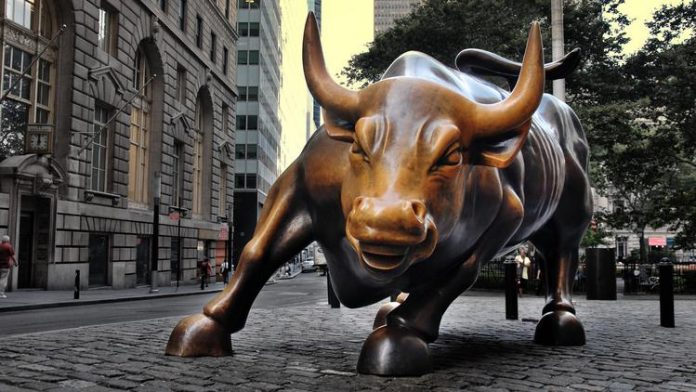A worse than expected jobs report and surging Covid-19 cases.
It’s the kind of the stuff that would’ve sent stocks spiraling in the past. But today, the market’s up. The Dow and S&P 500 just hit new all-time highs.
And investors continue to price-in a presumedly massive stimulus package.
Ironically, the bad November jobs data, released this morning, is likely a boon to short-term bulls. Politicians across the country are citing last month’s meager 245,000 payroll gain as evidence for even more stimulus. Dow-polled economists predicted an additional 440,000 new jobs in November.
The labor market fell flat in that regard. Unemployment, however, did drop to 6.7% (from 6.9%) as expected – something that’s certainly a welcome sight while many states reimpose lockdown conditions.
Still, Wall Street believes the jobs report could be enough to prompt urgent action from Congress.
“[This data] is beckoning lawmakers to act on additional fiscal stimulus measures in order to bridge the output gap in the economy until a vaccine is deployed and the longer they hold out the wider the gap may become,” explained Allianz strategist Charlie Ripley.
In a tweet shortly after the data was released, Senate Minority Leader Chuck Schumer confirmed Ripley’s assumption that the report would press lawmakers to act.
“This latest jobs report shows the need for strong, urgent emergency relief is more important than ever,” Schumer wrote.
“Senator McConnell must hear the pleas of the millions of struggling American families.”
McConnell and Schumer have been circling the drain on this issue for months, now. Republicans and Democrats both want big stimulus packages but can’t agree on how to divvy up the funds.
And when negotiations fail, either side blames the other for walking away from the table empty-handed.
But today, many analysts are convinced that a sagging labor market could be enough to finally secure a deal. Others, like TD Ameritrade chief market strategist JJ Kinahan, see a silver lining in the November jobs report, commenting that the data “was not as bad as it seems.” Kinahan says that a large chunk of the jobs lost last month came from the U.S. government as the 2020 Census count concluded.
He continued, adding:
“It’s really hard to estimate what these numbers are going to be when states are going from being completely shut down to being completely open. I think you’re seeing that in the market’s reaction.”
Kinahan’s absolutely right, a wide-scale reopening of the U.S. would have a profound impact on American labor. The services industry, which includes bars and restaurants, would see an immediate payroll lift as a result.
Commonwealth Financial Network CIO Brad McMillan shares Kinahan’s sentiment, but went even further in arguing that the jobs market is stronger than last month’s new 245,000 payrolls would indicate.
“[Average hours worked] remained strong, suggesting that overall labor demand remains healthy, and the drop in the unemployment rates suggests the labor market continues to tighten.”
Once vaccines are deployed on a wide scale, Kinahan and McMillan both expect a rapid bounce back in not just employment, but economic activity, too. Another observation that’s should prove accurate.
The next question, then, is how long that would take to happen. And, more importantly, if enough Americans are willing to take the fast-tracked vaccines. Pfizer (NYSE: PFE) and BioNTech (NASDAQ: BNTX) leaders say their companies will be ready to produce 1.3 billion vaccine doses next year.
If that projection is accurate, the vaccine demand will be met as production ramps up. Historically, though, new vaccines haven’t been met with much fanfare. The first mass-produced polio vaccine – the Jonas Salk vaccine – worked quite well and boasted a high efficacy rate, but manufacturing errors led to over 40,000 accidental polio infections. Two pharmaceutical companies responsible for making the vaccine – Cutter Laboratories and Wyeth Pharmaceuticals – failed to properly deactivate the poliovirus during production, allowing a live poliovirus into over 100,000 doses.
Over 250 cases of paralytic illness resulted from the mistake. Several children were left paralyzed, and some even died due to the manufacturing error.
Of course, this happened back in 1955. The pharmaceutical industry has come a long way over the last 65 years.
Still, the stigma surrounding new vaccines has persisted. People might not remember the Cutter and Wyeth disaster, but the idea of taking a vaccine that was rushed to market may be too bitter a remedy for many patients to swallow.
Or, in this case, inject.
We’ll find out soon enough how open Americans are to taking a Covid-19 vaccine en masse, but for now, it could be wiser to view the upcoming “vaccine renaissance” as anything but a guarantee. Yes, the coronavirus will eventually be defeated.
The world will mostly go back to normal at some point.
But until it does, the current bullish narrative is at risk of being derailed at a moment’s notice. Staying long on equities, while remaining skeptical about the ongoing vaccine rally, is likely the best move heading into the new year.
Regardless of how much higher equities climb.







